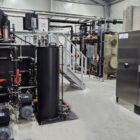Cavitation describes the formation and subsequent implosion of vapor bubbles in liquids when the local pressure falls below the vapor pressure of the liquid. This often occurs in high-speed systems or areas with large pressure differences, such as pumps, valves or turbines.
Technical development
Cavitation occurs when the static pressure of a liquid falls below the vapor pressure of the liquid at certain points, for example on the suction side of a pump. This causes vapor bubbles to form. These bubbles collapse as soon as they reach areas of higher pressure. The collapse generates shock-like pressure waves that can damage material surfaces.
Types of cavitation
- Hydrodynamic cavitation: Occurs in fluid flows, especially in pumps and turbines.
- Ultrasonic cavitation: Used in cleaning and chemical processes through the application of high-frequency sound waves.
- Vibration-generated cavitation: Is caused by mechanical vibrations.
Technical effects
- Mechanical damage: The implosion of the bubbles generates micro-jets and strong pressure waves that cause material erosion or pitting on metal surfaces.
- Loss of efficiency: In pump systems, cavitation leads to a drop in flow rate and efficiency.
- Noise development: Cavitation produces a characteristic noise, which is described as rattling or hissing.
- System failure: Pumps and valves can fail completely in the event of prolonged cavitation.
Areas of application and risks
Cavitation is critical in many industrial sectors:
- Industrial water treatment: Cavitation can damage pumps and valves in reverse osmosis or nanofiltration systems.
- Waste water treatment: Cavitation can occur at high flow velocities in pipelines and reduce the service life of the components.
- Power plant applications: Cavitation can reduce efficiency and cause damage in turbines and condensers.
Avoidance and control
- Optimization of the system design: Use of pumps with suitable NPSH values (Net Positive Suction Head) to ensure sufficiently high pressure.
- Pressure management: Installation of pressure regulators or bypasses to minimize pressure drops.
- Material selection: Use of cavitation-resistant materials such as stainless steel or special alloys.
- Speed control: Adjustment of the flow rate in critical areas.
Conclusion
Cavitation is an often underestimated but extremely important phenomenon in industrial water treatment. Controlling and minimizing it at the system design stage is crucial to increasing operating efficiency and ensuring the service life of the systems. With ALMAWATECH, customers benefit from robust, cavitation-optimized solutions that are designed for maximum reliability.
For further information on our products, please feel free to contact us at any time!








